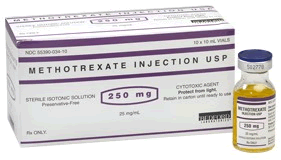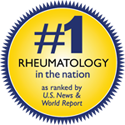
Background:
Oral vs. subcutaneous (sq) administration of methotrexate is generally considered equivalent in rheumatoid arthritis (RA) treatment. However, the enhanced bioavailability of sq methotrexate may make this route of administration preferable to the oral route in certain patients. Here, Braun et al (Arthritis Rheum 2008; 58: 73) report the findings of the first multi-center, prospective, randomized, blinded trial of oral vs. sq methotrexate in methotrexate nave patients with RA.
Methods:
Methotrexate and biologic-DMARD nave RA patients with high disease activity (defined as a DAS28 > 4) were blindly randomized to one of two groups:
- oral methotrexate (po MTX) 15 mg weekly oral methotrexate + placebo injection
- sq methotrexate (sq MTX) 15 mg weekly sq methotrexate + oral placebo
Subjects were continued on stable background NSAIDs and low-dose prednisone. Folic acid was administered to all subjects at a dose of 5 mg per week. No other injected medications or anti-emetics were permitted. The primary outcome measure was the ACR20 response at 24 weeks, with ACR50/70/90, DAS28, EULAR response criteria, and time to ACR20 as secondary outcome measures.
A rescue arm was utilized, such that subjects in the po MTX group who had not achieved an ACR20 response by week 16 were blindly crossed over to the sq MTX group. Subjects in the sq MTX group not achieving an ACR20 response at 16 weeks had their sq MTX dosage increased to 20 mg per week.
Results:
187 and 188 subjects (384 total) were randomized to the po MTX and sq MTX groups, respectively. Subjects were primarily female (74 79%) with a mean age of 59 years. RA disease characteristics included a mean disease duration of 2.1 2.5 months and high baseline disease activity (mean DAS28 > 6.0). Baseline characteristics were balanced between the two treatment groups. Eighty-nine percent of enrolled subjects completed the 24 weeks of the study with the proportion of completers balanced between the two treatment allocations. Twenty subjects in the po MTX group were rescued at 16 weeks and were crossed over to sq MTX, while 22 subjects in the sq MTX group had their sq MTX dosage increased to 20 mg per week at that time.
Efficacy endpoints tended to favor the sq MTX group:
| Oral MTX n=187 |
SQ MTX n=188 |
p | |
| ACR20 | 70% | 78% | 0.04 |
| ACR50 | 54% | 62% | NS |
| ACR70 | 33% | 41% | NS |
| EULAR Remission | 24% | 34% | <0.05 |
There was no difference in safety or toxicity between the two groups.
Conclusions:
The clinical efficacy of subcutaneous methotrexate is superior to the orally administered form without an increase in adverse events.
Editorial Comment:
This is the first placebo-controlled, double-blind study to evaluate the efficacy of oral vs. sq methotrexate in early RA. One aspect of this study that may be missed are the overall excellent responses achieved with only a moderate dose of methotrexate, highlighting the potency of methotrexate as a DMARD which can often be overlooked in clinical trials that typically enroll only subjects with inadequate responses to methotrexate. While these results seem to suggest that sq methotrexate should be chosen first choice over oral, one issue with the study design may compromise these conclusions. The methodologic design of the rescue arm favors the sq methotrexate group, in that, on average, approximately 10% of the subjects in this group received a 25% higher dose of methotrexate than did those in the oral group (who could never receive a dose higher than 15 mg as part of the protocol). This difference could be responsible for the observed differences in the two groups. A sub-analysis excluding the rescue subjects would help to answer this discrepancy.

